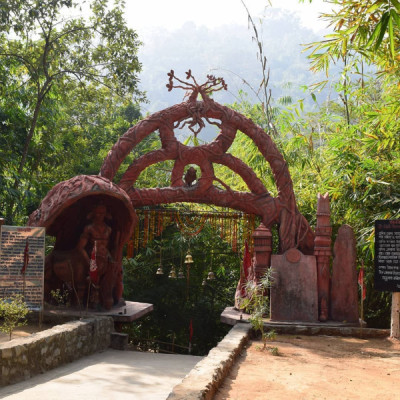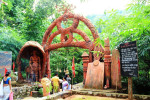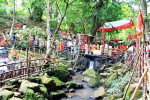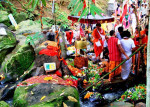In Depth
It is situated at the hill just besides the Deepor Beel. It is believed that Shiva had incarnated here to destroy a demon called Bhimasura and protect his devotees. There is no temple here. Instead there is a hill stream surrounding a linga and one can observe continuous water flowing over the linga. There is also a temple dedicated to Ganesha on the halfway to this dham. The road leading to the linga is very beautiful with hills, streams and bamboo grooves.
Spiritual Significance of Bhimasankar Dham Jyotirlinga Temple
Dedicated to Lord Shiva, the temple attracts devotees and spiritual seekers from all over Assam and neighboring states. The serene natural surroundings of the temple enhance its spiritual aura, making it a peaceful and powerful place of worship. The Shiva Linga here is worshipped with great devotion, especially during Mahashivratri, when thousands of pilgrims gather to offer prayers and perform rituals.
According to Shiva Purana, Kumbhakarna (brother of Lanka king Ravana) was in love with Karkati, daughter of the king of Patal Lok. When Ravana came to invite Karkati's father and Kumbhakarna to fight with Rama, Kumbhakarna refused to come until Ravana allowed him to marry Karkati. At last on the advice of Narada, Ravana agreed and Kumbhakarna married Karkati. After marriage Kumbhakarna left Karkati to participate in the war. After Kumbhakarna's death, Karkati gave birth to Kumbhakarna's son; who was named as Bhimasura. Bhimasura did penance to receive a boon from Brahma of immense strength and to be not killed by Vishnu by any means. He later challenged Vishnu to fight with him. Vishnu agreed and deliberately lost the war to keep Brahma's boon. This made Bhimasura very arrogant and he started conquering various kingdoms. He imprisoned the king Priyadharman (also called Kamrupeshwar) and his wife Dakshinadevi of Kamrupa.
King Priyadharman and his wife were worshiping Shiva even in prison. When Bhimasura sent his army to stop the king from worshiping, they were destroyed by rage of Shiva. Bhimasura wanted to kill king Kamrupeshwar. When Bhimasura attacked the king was busy in worship at this place, his sword fell on the linga instead of the king. Instantly Shiva appeared and killed Bhimasura. The sweat from his body formed a river, said to be the same steam which is running over the Jyotirlinga now. The place where the king worshiped Shiva was named after this episode as Bhimeswar. On the request of the gods, sages and devotees, Shiva agreed to reside there eternally by the name of Bhimashankar.
Mythological Belief of Bhimasankar Dham Jyotirlinga Temple
According to local folklore, this site is where Lord Shiva took the form of Bhimashankar to defeat the demon Bhimasura, the son of Kumbhakarna. Many believe that this temple is an extension or reflection of the main Bhimashankar Jyotirlinga in Maharashtra, offering an alternative pilgrimage for devotees in the Northeast.
Architecture and Temple Premises of Bhimasankar Dham Jyotirlinga Temple
The temple architecture reflects a blend of traditional Hindu styles with a simplistic and spiritually inviting design. Surrounded by dense greenery and scenic landscapes, Bhimasankar Dham offers a calm atmosphere ideal for meditation and inner reflection.
Accessibility and How to Reach Bhimasankar Dham Jyotirlinga Temple
Bhimasankar Dham is located approximately 25 km from Guwahati city center, near the Garchuk-Pamohi area. It is easily accessible via road by private vehicles, taxis, and local transport. The nearest railway station and airport are located in Guwahati, making it a convenient spiritual destination for both locals and tourists.
Best Time to Visit Bhimasankar Dham Jyotirlinga Temple
While the temple is open throughout the year, the best time to visit is during:
Mahashivratri (February–March)
Shravan month (July–August)
During these periods, special pujas and religious events are organized with great fervor.
Visitor Tips of Bhimasankar Dham Jyotirlinga Temple
Dress modestly and maintain silence within the temple premises.
Carry your own water and basic supplies, as facilities around the temple may be limited.
Avoid visiting during the peak afternoon heat; early mornings are ideal.
Conclusion
Bhimasankar Dham Jyotirlinga Temple in Guwahati is not just a sacred Shiva temple but a spiritual retreat for devotees seeking peace and divine connection. Whether you’re a devout follower or a curious traveler, a visit to this mystical shrine offers a blend of devotion, folklore, and natural beauty – making it one of Assam’s most spiritually enriching experiences.





